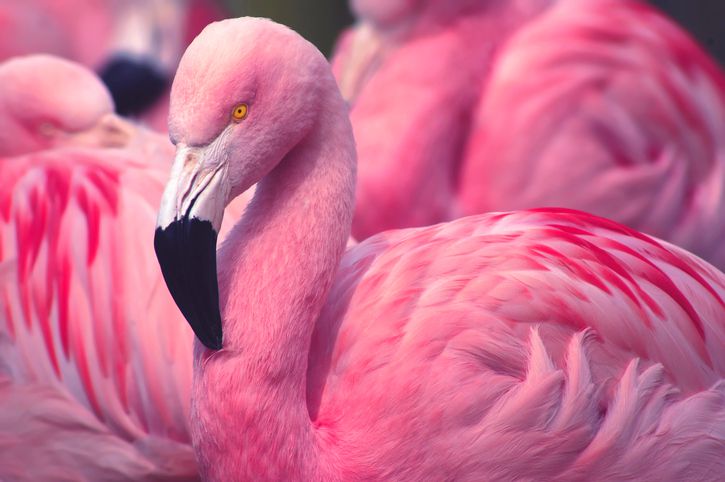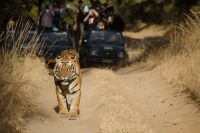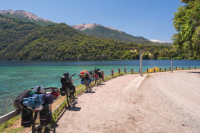As a country that covers over 107 million sq.-miles (2.78 km²), it should come as no surprise that a huge variety of wildlife inhabit different parts of the Argentine countryside. Ranging from the world’s largest rodent to parrots that burrow in rocky cliffs to nest, these five animals in Argentina prove why this nation is a perfect fit for travelers keen to encounter intriguing creatures in their natural habitats.
Capybara
The largest rodent in the world, capybara are found along waterways throughout the marshes, swamps and lakes of South America. Closely related to guinea pigs and rock cavies, they have reddish-brown fur, webbed toes for gliding efficiently through water and weigh up to 146 lb (66kg). They live in groups of around 20 individuals and their main predators include anaconda, caiman, puma and jaguar.
 Habitat in Argentina: Known as carpinchos in Argentina, they live in the Iberá Wetlands in the northern Corrientes Province.
Habitat in Argentina: Known as carpinchos in Argentina, they live in the Iberá Wetlands in the northern Corrientes Province.
Jaguar
The largest feline in the Americas, and the third largest in the world, the jaguar is an animal that has become a symbol of the Amazon Rainforest, although its habitat actually extends from Arizona to the north of Argentina.
It favors living in places with an abundant supply of water, such as rainforests, swamps and areas of dense woodland and its known as a proficient swimmer. It feeds by stalking, hunting dozens of different species as prey and using its incredibly powerful bite to kill.
Habitat in Argentina: Jaguar populations in Argentina have seen a huge decrease due to habitat loss and ranchers who kill them in retaliation against loss of livestock.
Although it’s unlikely you’ll see a jaguar in Argentina, conservation efforts in the Iberá Wetlands have reintroduced this big cat and hope to re-establish a population over the next few decades, while small numbers are known to inhabit parts of the Misiones Province.
Burrowing parrot
Burrowing parrots are remarkable for various reasons. Not only do they form the largest colonies of all species of parrots, but they actually dig their nests, requiring soft sandstone or limestone in which to burrow. A monogamous bird, they migrate north each winter and return in the spring to the same nests.
 Habitat in Argentina: The largest colony of burrowing parrots exists on the Patagonian coast at El Cóndor in Río Negro Province, where an estimated 180,000 birds nest along the cliffs.
Habitat in Argentina: The largest colony of burrowing parrots exists on the Patagonian coast at El Cóndor in Río Negro Province, where an estimated 180,000 birds nest along the cliffs.
Patagonian mara
Also known as the Patagonian cavy, the mara is another large rodent from the same family as the guinea pig, although they resemble a rabbit or a small deer, with long limbs and hoof-like feet. They are native to Argentina and inhabit area of grasslands or areas with a high density of shrub cover, living in communal dens where the pups of up to 20 pairs are raised.
Habitat in Argentina: They are registered as near threatened on the IUCN Red List due to habitat loss and competition from other herbivores but can be spotted in Argentina, from Catamarca Province to 50˚ south latitude.
Flamingos
Three species of flamingo breeds in South America: Andean, Chilean and James’s. As sympatric animals, they live together in colonies, mainly in the salt flats and lakes of the Andes of Peru, Bolivia, Chile and Argentina. These three species feed on algae and plankton and they can use glands in their nostrils to expunge excess salt from saline water.
 Habitat in Argentina: All three species of flamingo can be seen in Argentina, particularly in places such as Salinas Grandes, Argentina’s largest salt flats located in the Jujuy and Salta provinces. Chilean flamingos, however, inhabit lakes across Argentina, all the way down to Tierra del Fuego in the far south.
Habitat in Argentina: All three species of flamingo can be seen in Argentina, particularly in places such as Salinas Grandes, Argentina’s largest salt flats located in the Jujuy and Salta provinces. Chilean flamingos, however, inhabit lakes across Argentina, all the way down to Tierra del Fuego in the far south.
Read about other intriguing animals in Argentina
For further information about animals in Argentina, check out our guide to the animals you can expect to see in the central grasslands, a region of fertile plains and diverse wildlife.
No comments yet
There are no comments on this post yet.






Leave a comment